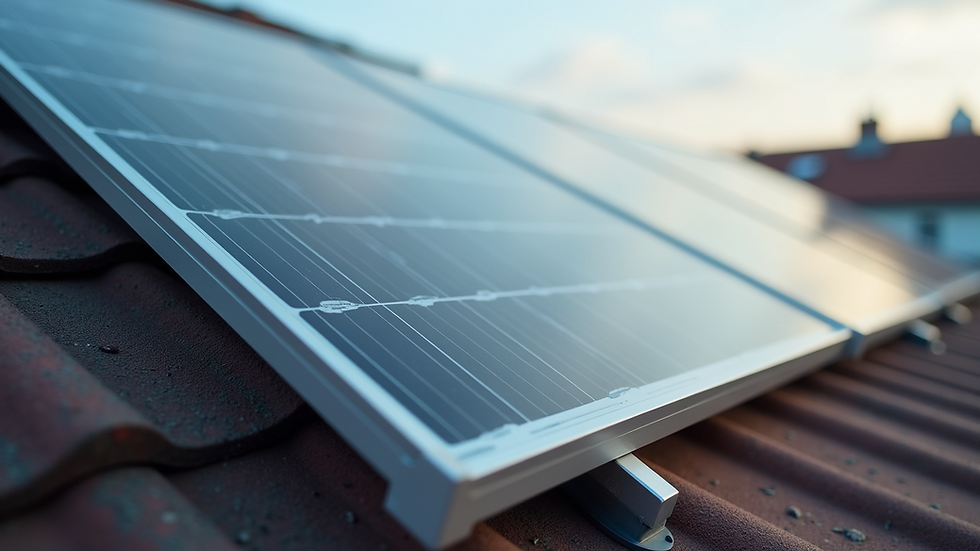Exploring the Benefits of Monocrystalline Solar Panels for Sustainable Energy Solutions
- Bill Adams
- Jul 16
- 3 min read
As the world moves towards greener energy solutions, solar power is at the forefront of this shift. Monocrystalline solar panels have emerged as a top choice due to their impressive efficiency and performance. This blog dives into the many advantages of monocrystalline solar panels to help you decide if transitioning to solar energy is right for you.
What Are Monocrystalline Solar Panels?
Monocrystalline solar panels are crafted from a single crystal structure of silicon, allowing them to convert sunlight into electricity more efficiently than other panel types. Easily recognizable by their dark black color and rounded edges, these panels are popular among homeowners and businesses alike.
The production process for monocrystalline panels also enhances their performance. Silicon is grown in cylindrical shapes to create larger solar cells. This leads to efficiency ratings that can exceed 22%, making them an outstanding option for spaces where every inch counts.
Advantages of Monocrystalline Solar Panels
1. High Efficiency Rates
Monocrystalline solar panels are known for their high efficiency, typically ranging between 15% and 22%. In fact, studies show that they can generate up to 20% more electricity compared to their polycrystalline counterparts in the same space. This efficiency makes them perfect for residential areas with limited roof space, boosting energy production without requiring extensive installations.
2. Space-Saving Design
Because they require less area to produce the same power output as other types, monocrystalline panels are a smart choice for properties with restricted roofs. For instance, a typical rooftop installation might generate 20% more energy using monocrystalline panels than using polycrystalline versions. Homeowners can maximize their solar output without major modifications to their roofs.
3. Longevity and Durability
Monocrystalline panels are built to last. Most manufacturers offer warranties of over 25 years, with many installations still operating efficiently beyond 30 years. Their strong design makes them resistant to environmental challenges like extreme heat and heavy snowfall. This durability leads to less frequent replacements and lower long-term costs.
4. Aesthetically Pleasing
With a sleek, uniform appearance, monocrystalline panels can enhance the look of your home. They provide a modern aesthetic that fits well with most architectural styles, which is especially important for homeowners concerned about how solar installations impact their property’s appearance.

5. Excellent Performance in Low Light
One standout feature of monocrystalline panels is their effectiveness in low-light conditions. They can produce significant energy even on cloudy days, unlike many other solar panels. In fact, they generate about 15% to 20% more energy in overcast conditions. This reliable performance ensures that homeowners benefit from solar power year-round, regardless of climate changes.
Comparing Monocrystalline to Other Solar Panel Types
1. Monocrystalline vs. Polycrystalline
When comparing monocrystalline to polycrystalline panels, it is essential to note the difference in efficiency. Polycrystalline panels typically range from 13% to 16% in efficiency. This means more polycrystalline panels are necessary to achieve the same energy output as a smaller number of monocrystalline panels, potentially increasing overall costs and space requirements.
2. Monocrystalline vs. Thin-Film
Thin-film solar panels are lighter and more flexible, yet they usually offer lower efficiency, sitting between 10% and 12%. This makes them suitable for niche applications like portable solar devices. However, for most residential uses, monocrystalline panels provide a better energy solution and return on investment.
Cost Consideration
While monocrystalline solar panels often have higher upfront costs than other options, their efficiency can lead to substantial long-term savings. For example, homeowners could save an average of 25% on energy bills annually after switching to solar power. Additionally, various incentive programs, including grants and tax credits, can lower the initial investment and make these panels a more budget-friendly choice.
Environmental Impact
Opting for monocrystalline solar panels not only benefits your wallet but also contributes positively to the environment. Solar energy cuts down on fossil fuel reliance, decreasing greenhouse gas emissions. For instance, switching to solar can reduce carbon dioxide emissions by several tons per year, depending on your energy usage.
As solar technology advances, the manufacturing process is becoming more sustainable. Companies are now focusing on reducing waste and employing eco-friendly materials, making solar panels an even more attractive option for environmentally-conscious consumers.
Final Thoughts
Monocrystalline solar panels are an effective choice for anyone seeking sustainable energy solutions. Their high efficiency, longevity, and attractive appearance position them as favorites among many homeowners. By investing in these advanced panels, you not only decrease your energy costs but also make a positive impact on the environment.
As you evaluate your solar options, carefully consider the many benefits of monocrystalline panels. With ongoing advancements in solar technology, adopting renewable energy is now more feasible and rewarding than ever. The choice of the right solar panel can be a significant step toward a more sustainable lifestyle.




Comments